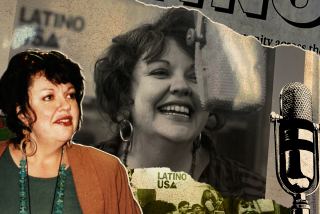Media : A Good Kind of ‘Crazy’ : Radio Tam Tam is part of a groundbreaking program in Santos, Brazil, that is out to change attitudes about mental illness. The stars of the show are patients.
SANTOS, Brazil — When the people at Radio Tam Tam make cracks about being crazy, they’re not just joking. In Brazilian slang, tam tam means insane, and all the people who work on the daily radio program are mental patients.
Conceived as part of a groundbreaking mental health program in Santos, the nearly 2-year-old show has since gone far beyond therapy. It has become one of this port city’s most popular radio programs and is helping to change popular attitudes toward mental illness, not only here but throughout much of the country.
Radio Clube de Santos, the AM station that airs the program every weekday at 4 p.m. and syndicates it to stations broadcasting in 14 of the country’s 23 states, is so happy with public response that it wants to expand the Friday edition from the current 30 minutes to a full hour.
Owned by legendary soccer star Pele, Radio Clube funds Radio Tam Tam out of grants from the city but expects that the longer format will allow it to become a profit-maker.
“At first we saw the show as simply a therapeutic venture,” station manager Arnaldo Goncalves said, “but it has turned out to be a very enjoyable and popular show, and we intend to continue supporting it. I have no doubt that it could be a commercial as well as a popular success.”
The program is rooted in groundbreaking work by the city’s leftist government to move mental patients out of an overcrowded, brutal and understaffed asylum on the outskirts of town and put them back into mainstream society.
When the gates of the 180-bed Anchieta Health Center were opened three and a half years ago, 600 patients lived there. It had only five half-time doctors, and only one was a psychiatrist. Strong mood-altering drugs and electroshock therapy were among the most-used treatments.
“A house of horrors,” Radio Tam Tam coordinator Renato Di Renzo calls it. Di Renzo is an art therapist with the city’s health department.
After exposing the Anchieta hospital, the city moved all treatment to decentralized clinics and passed an ordinance prohibiting the construction of mental hospitals. Instead of admitting mental patients to institutions, the city helps them find work. Those who cannot work participate in activities set up by the mental health program.
To this end, city health department chief David Capistrano called in Di Renzo to set up a variety of art, craft and environmental projects in late 1989. In addition to the radio show, the Tam Tam Project--serving several hundred patients--now includes a newspaper, clothing, stationery, catering and jewelry workshops and a patient-staffed “Clean Trash” recycling program.
The products of the workshops are sold to local wholesalers and shops, and the patients are paid for what they produce. Profits are plowed back into the project.
Now all but a handful of the former Anchieta residents are living in normal community settings, and the stars of Radio Tam Tam are at the forefront of an attempt to make sure that the newly liberated citizens are not only seen but heard.
Radio Tam Tam first hit the airwaves in November, 1990. Pointing to an elderly man who is slowly regaining his ability to speak after being abandoned for more than a decade in Anchieta, Di Renzo says getting patients out of “destructive” institutions is not enough.
“When we started reforming the mental health system we wanted to make sure that the mentally ill had a voice,” he said. “While people like this old man are still too damaged to go on the air, Radio Tam Tam is an attempt to reinforce the fact that those peoples’ lives have value. This is important not only for the people who run it. It is important for the other patients and for the population at large.”
As Di Renzo speaks, a young man walks over and introduces himself: Elias Do Carmo, 17. Suffering from occasional but severe mood swings, Do Carmo was abandoned by his parents and shuffled between a variety of institutions and living on the streets. A city youth worker met him on a local beach. Impressed with Do Carmo’s ability to mimic, he told him about Radio Tam Tam.
“I didn’t believe them when they said I could do radio,” Do Carmo said. “But I gave it a try. Now I have a job and a place to live.” He is one of Radio Tam Tam’s stars, specializing in caricatures of leading television and political personalities.
“When we first tried to start the show, many people were afraid of it,” Di Renzo said. “They were worried that ‘the crazies’ might say bad words on the air or slobber into the microphones. Now, however, we could probably take it to almost any station and get it on the air.”
While none of the patients get paid for the show itself, they have used their new-found popularity and the Radio Tam Tam name to start a professional theater group. Their stage shows are in great demand throughout southern Brazil, and they are frequently flown around the country to do live performances at arts festivals or to appear on television.
While only 10 patients work on the show at any one time, many other young mental patients aspire to a spot on Radio Tam Tam. According to Rosangela Menezes e Silva, a worker with the Santos Health Department, the show not only helps the patients but helps the community to understand the innovative health programs of the local Workers Party administration.
“The show is the thing that keeps our reforms in the public eye,” she said.
Despite its popularity, Radio Tam Tam does have its limitations. The biggest obstacle to a longer and more commercial format has been the staff itself. Menezes e Silva said the patients, many of them high school students, worry that their mental problems might make it difficult for them to live up to a bigger commitment.
The lead announcer, Alberto Pereira, has had a stream of offers to host his own show on other stations but has turned them down. Following a recent emotional crisis, Pereira decided to take some time off.
Despite the limitations, a key ingredient in the show’s success is its unflinching approach to the subject of mental illness. Calling themselves louco-tores (a pun on the Brazilian words louco , or “crazy,” and locotores , or “announcers”), they don’t try to hide the fact that they have psychological difficulties. In improvised sketches, they poke fun at the way society treats their illnesses.
When told that many people in the United States would shy away from using such strong, negative terms for the mentally ill, Di Renzo seemed surprised. “Talking like this, getting the facts in the open, is the best medicine,” he said. “This sort of thing is nothing to hide.”
In the end, Radio Tam Tam’s greatest success may be its ability to perform a difficult balancing act. On one hand, its audience demonstrates that Radio Tam Tam has wide appeal. On the other, its performers insist on being different.
As one show reached its final seconds, Everaldo Vieira put on his best baritone announcer’s voice and declared: “We now return you to your normal programming.”
More to Read
Sign up for Essential California
The most important California stories and recommendations in your inbox every morning.
You may occasionally receive promotional content from the Los Angeles Times.










